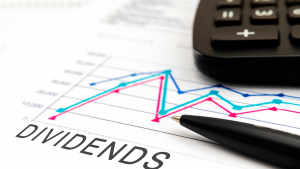When interest rates were at or near zero, dividend stocks outpaced many fixed-income options even though the latter offer a nearly risk-free rate of return. Things are a little different in 2024 with many bonds and Treasury notes having returns at or near 5%. That doesn’t mean you should ignore the potential of dividend-paying stocks.
But when it comes to the best stocks for passive income, you can’t simply look at dividend yield. It’s nice to see a yield of 5% of more, but the key to turning dividend stocks into income idols is an ability to pay, and increase, a dividend over time. Particularly when you can accumulate shares for a fair price. That’s the sweet spot for investors. And that’s a trait shared by the dividend royalty you’ll find here.
Realty Income (O)

Realty Income (NYSE:O) is a real estate investment trust (REIT) that focuses on the commercial real estate sector. That sector is still struggling to recover from the twin crises of the global pandemic and rising interest rates.
However, Realty Income benefits from its triple-net lease basis model in which tenants pay for taxes, maintenance, and utilities. This allows the company to generate 2-3% adjusted funds from operations (AFFO) without relying on equity markets.
Realty income’s customer base includes companies such as Walmart (NYSE:WMT), Starbucks (NASDAQ:SBUX) and FedEx (NYSE:FDX) that ensure an uninterrupted revenue stream. These kinds of companies will be the ones consumers flock to when they get a little relief from interest rates.
REIT’s are required to return a significant percentage of their earnings to shareholders. That usually takes the form of a dividend. Still, Realty Income offers both a high-yield (5.9%) dividend and one that is increasing. The company has increased its dividend for the last 30 consecutive years, Plus, investors can generate significant passive income with a modest investment as O stock trades for around $53 per share as of June 14.
Coca-Cola (KO)

When it comes to income icons that are also brand icons, there are few rivals to Coca-Cola (NYSE:KO). This is an easy choice for investors looking to generate significant income from dividend stocks.
Coca-Cola is not a flashy company, In fact, it’s too boring for many investors. One notable exception to that line of thinking is Warren Buffett who makes KO stock one of his core holdings. The reason is consistent performance which leads to cash that can be returned to shareholders. And the company is showing investors that it can relate to today’s consumers both in terms of new product lines and methods of communication.
The company’s dividend yield of 3.1% isn’t going to be considered a high-yield dividend. But Coke is a dividend king that has increased its dividend for 63 consecutive years. Many traders will stay away from KO stock because of its middling performance in the last five years. But that’s not the best way to evaluate the company. In the last 20 years, the stock has delivered a total return of over 340%.
Fortis (FTS)

Utility stocks are known for being reliable dividend stocks. However, Fortis (NYSE:FTS) stands out in a sector that has been outperforming the market in 2024. The Canadian company operates 10 regulated utilities in the United States, Canada, and the Caribbean.
Utilities provide a predictable revenue stream, but investors shouldn’t ignore the growth opportunity from Fortis. The company has generated a compound annual growth rate (CAGR) of approximately 10% over the past 10 years. A good bit of that comes from the dividend yield which was 4.37% on June 14.
Fortis does have a premium valuation for a utility stock at about 16x forward earnings. To justify that premium, investors should consider the company’s 5-year, $25 billion strategic investment program that is part of the company’s efforts to achieve net-zero carbon emissions. Plus, if interest rates do start to fall, the company is likely to find a more agreeable audience for regulatory rate increases.
On the date of publication, Chris Markoch did not have (either directly or indirectly) any positions in the securities mentioned in this article. The opinions expressed in this article are those of the writer, subject to the InvestorPlace.com Publishing Guidelines.
Chris Markoch is a freelance financial copywriter who has been covering the market for over five years. He has been writing for InvestorPlace since 2019.
